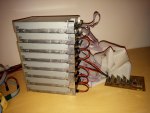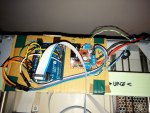
Remember the famous floppy drives? They’re back… with multiplied force (yes, THAT „force”) and some friends!
I have bought some more drives in order to expand the previous project back in 2012, which spent four years in a carton box. Together with new floppy drives, some more hardware has arrived: hard disk and optical scanners. Now I have the whole computer hardware orchestra – 64 floppy drives, 8 hard disks and 2 scanners – The Floppotron.
How does it work? The principle is simple. Every device with an electric motor is able to generate a sound. Scanners and floppy drives use stepper motors to move the head with sensors which scans the image or performs read/write operations on a magnetic disk. The sound generated by a motor depends on driving speed. The higher the frequency, the greater the pitch. Hard disks use a magnet and a coil to tilt the head. When voltage is supplied for long enough, the head speeds up and hits the bound making the „drum hit” sound. The disk head coil can also be used as a speaker to play tones or even music, but… that would be too easy and too obvious.





Host application was written in Python 2.7. I wrote it mostly on some boring lectures when I was still studying at the university, so it’s a one big mess, but… at least it does the job. It parses the simple language used for writing note sequences arranged in tracks tied to a specific controller / channel and merges those parallel tracks into one command list which is transferred over COM port. It can also partially generate „song script” from MIDI file which speeds up the „song porting” process.
Like the project? Here’s some another records.

 Pobierz plik: entry_phone_hack_0.1.zip
Pobierz plik: entry_phone_hack_0.1.zip

 It’s been awhile since my last post… Work, studies and other stuff.
It’s been awhile since my last post… Work, studies and other stuff. Dawno tu nic nie pisałem z powodu braku czasu – praca, studia, itp.
Dawno tu nic nie pisałem z powodu braku czasu – praca, studia, itp.